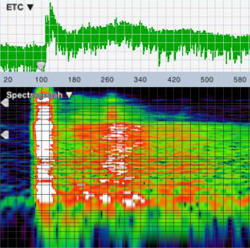
Occasions where automatic delay measurements might not work well include measurements of low-frequency devices or any case where you’re trying to measure a directional full-range system well off axis, in a location where a prominent reflection can dominate the high frequencies.
In the latter case, it’s possible for reflected HF energy to form a higher peak later than the arrival of direct sound, requiring you to visually inspect the IR data to find the first arrival.
Reflection Analysis. Another common use for IR measurements is in evaluating the impact of problematic discrete reflections. Reflected sounds can be beneficial or detrimental to a listener’s perception of sound quality and/or speech intelligibility, depending on a number of factors.
These factors include the type of program material being presented (generally, speech or music), the arrival time and overall level of the reflected sound relative to the level of direct sound, and the frequency content and the direction from which they arrive. As a general rule, the later they arrive and the louder they are (relative to direct sound), the more problematic they tend to be.
Reverberation Time (T60, RT60…). Reverberation time is kind of the grandfather of quantitative acoustical parameters. First proposed by Walter Sabine more than 100 years ago, T60 or RT60 reverberation time is the time that it takes for reverberant in a room sound to decay by 60 decibels from an excited state (after the excitation signals stops). It is one of the most widely used (and in some cases perhaps misused) quantities in room acoustics.
Although it is quite possible for two rooms with identical reverberation times to sound very different, when evaluated band-by-band it can still give you some idea as to the overall character of the reverberant field in a given room. In concert halls it can give you an idea of perceived warmth and spaciousness for music. In auditoriums, it is often used as a rough predictor of speech intelligibility.
Early Decay Time (EDT). Early decay time ends up being the decay time for direct sound and earliest, lowest-order reflections. Since the earliest reflections tend to be the most beneficial in terms of separating sounds we want to hear from reverberation and background noise, EDT can give you some clues about overall clarity and intelligibility in a room and/or system. EDT, like RT60, is conventionally normalized to the time it would take for the system to decay 60 dB at the measured rate of decay.
Early-To-Late Energy Ratios. Early to late energy ratios are a direct measure of the sound energy arriving within some specified interval following the arrival of direct sound, vs the energy in the remaining part of the IR. These provide a more direct method of evaluating the relationship between beneficial direct sound and early reflections that a listener hears versus the amount of (potentially detrimental) reverberation and noise, than inferences made from the early and reverberant decay rates.
Speech Intelligibility Modeling. Early to late energy ratios such as C35 and C50 have long been used as objectively measurable predictors of subjective speech intelligibility. In the 1970s Victor Peutz came up with Articulation Loss of Consonants (ALCons), a predictive metric for intelligibility of intelligibility based in the volume of a room and its reverberation time, the directivity of loudspeakers and distance from source to the listener.
Later on, Peutz revised the equation to use a direct-to-reverberant energy ratio in place of volume, distance and loudspeaker Q, making ALCons a directly measureable quantity. More recently, the speech transmission indexes (STI and STIPA) have emerged as metrics that are generally more robust. All of these can be calculated from the impulse response of a system.
Thanks to Rational Acoustics for providing this article. Go here for direct download (pdf) of the entire guide.
